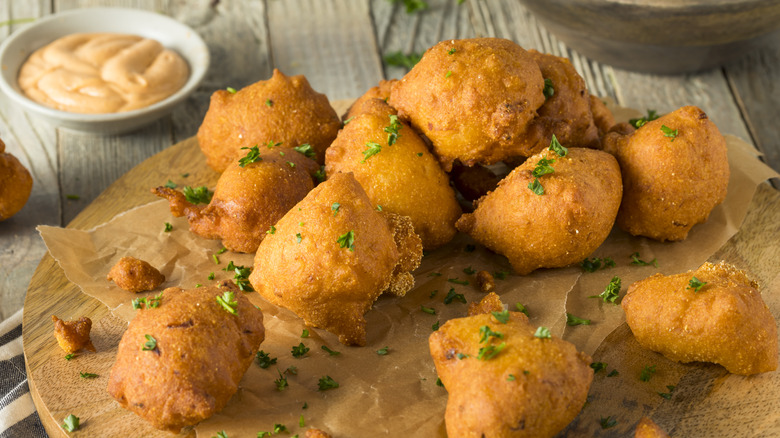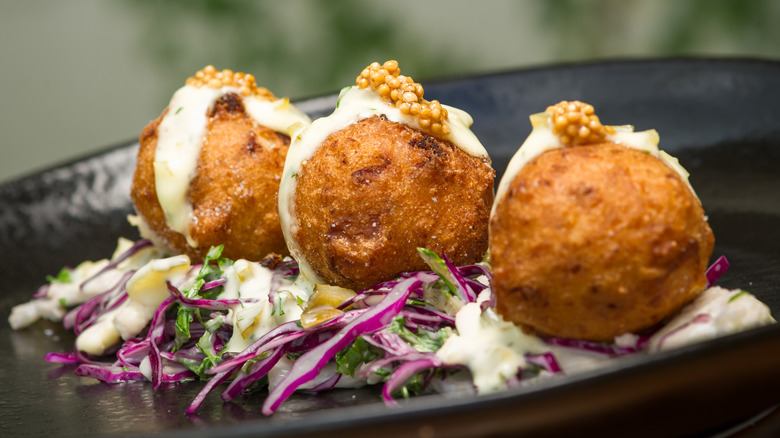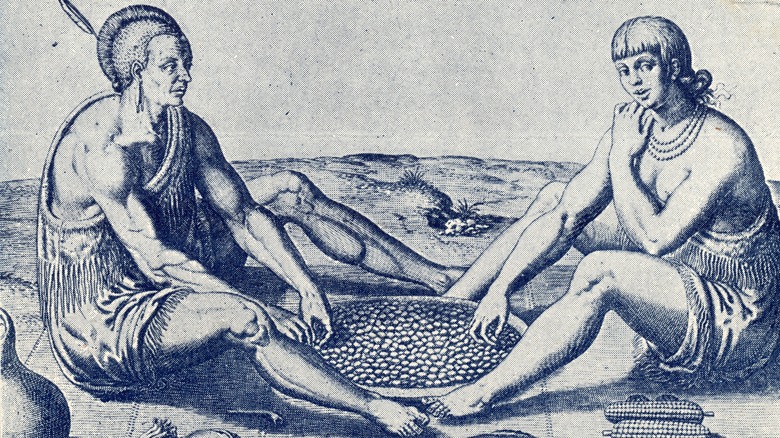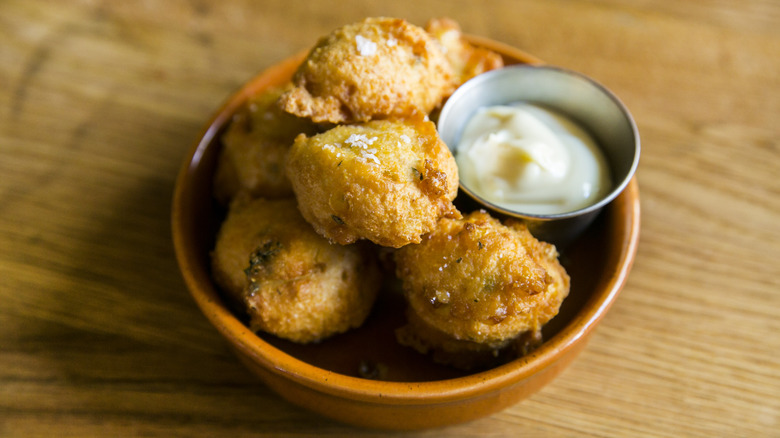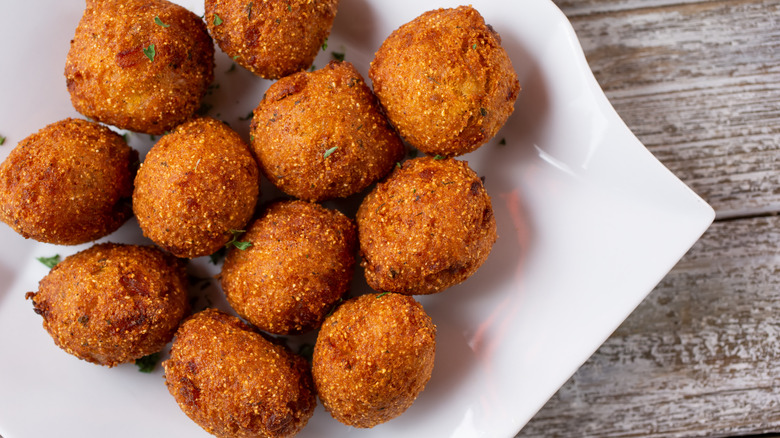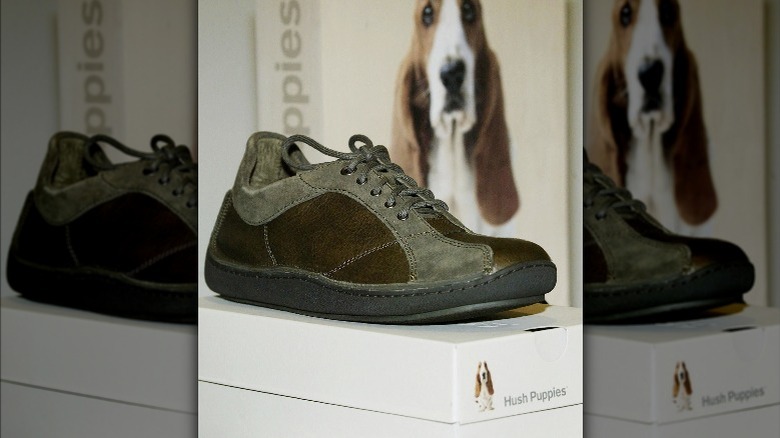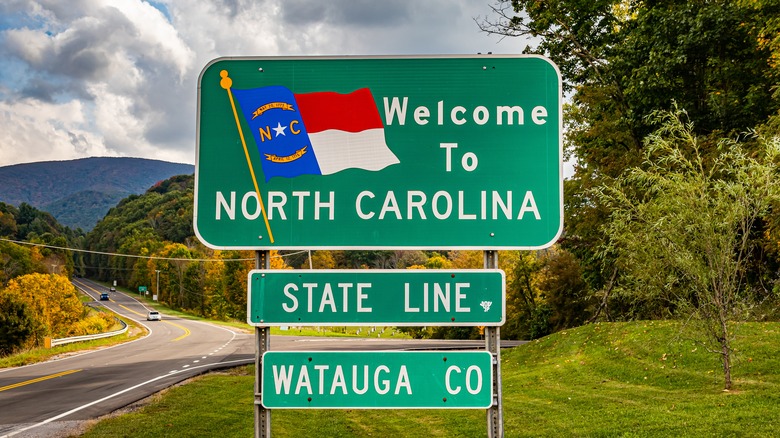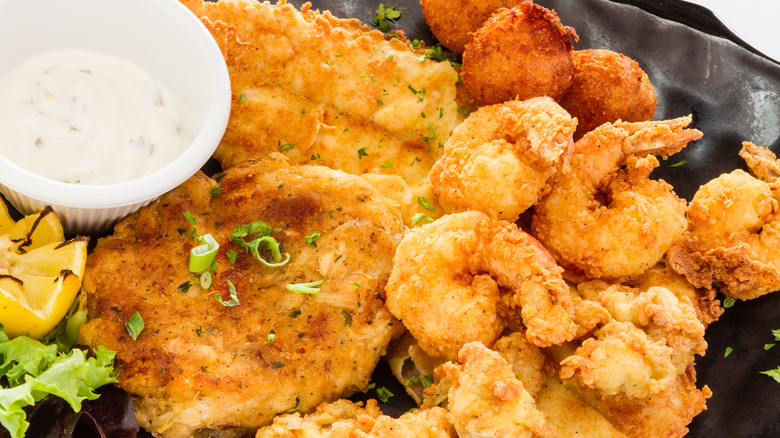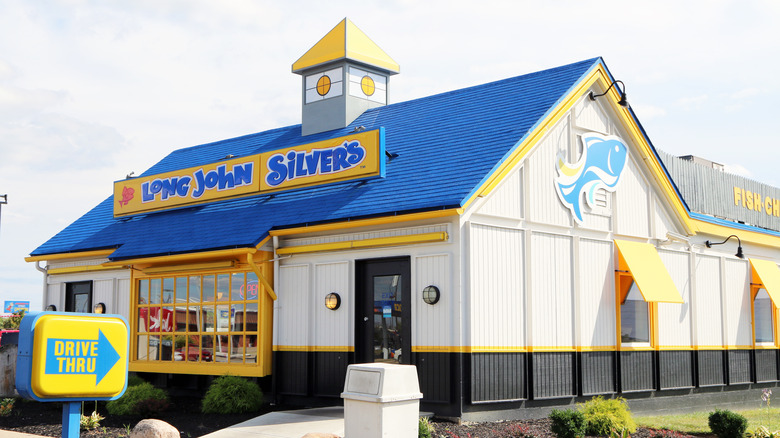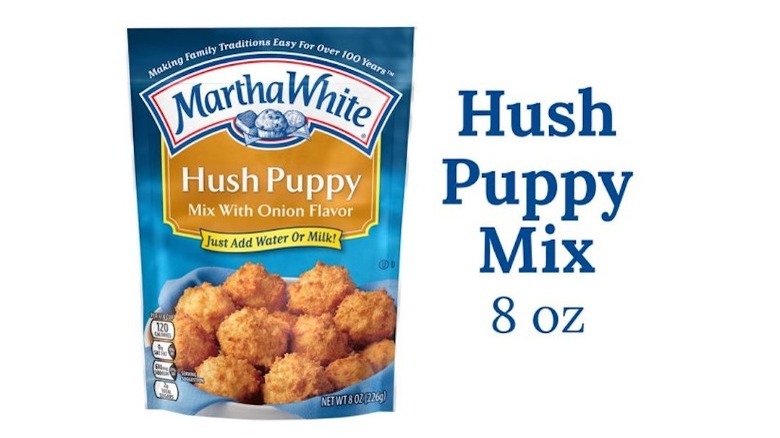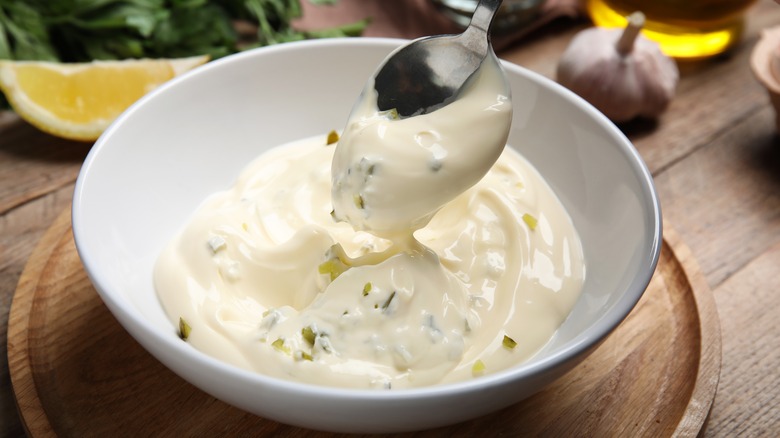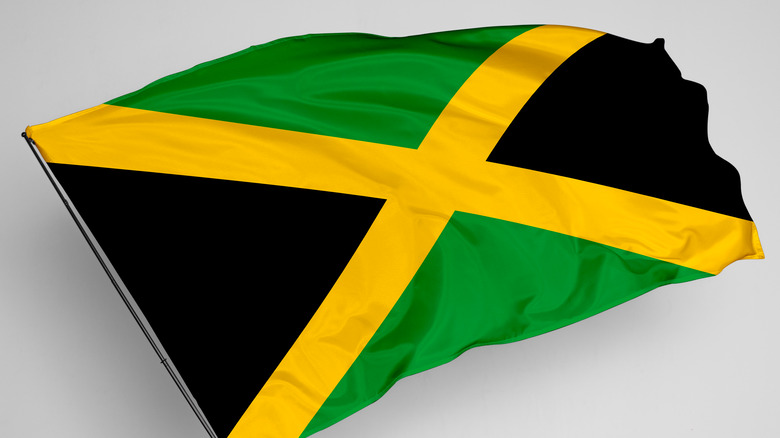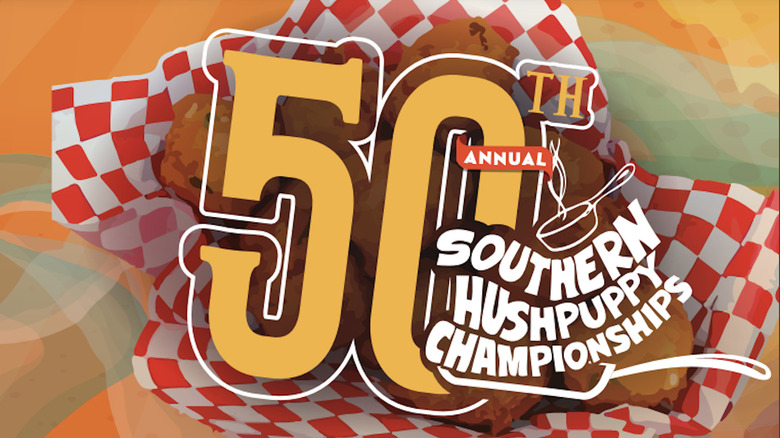The Ultimate Guide To Hush Puppies
We may receive a commission on purchases made from links.
The hush puppy is more than just a food with a fun name. Despite the canine moniker, no puppies are involved in creating this delectable treat. That being said, both the naming and the creation of the hush puppy come with a somewhat fishy history. In fact, tall tales involving everything from French nuns to hunters have been linked to their origin. One thing is certain: since their creation in the early 20th century, these sweet and savory treats made with cornmeal have become popular in the hearts and stomachs of Americans (via The Southeastern Dispatch).
While they once seemed to be exclusive to tables at southern fish fries, this crunchy, corny side dish can now be found all over the country. With that expansion, though, comes questions. If you find yourself wondering about the history of the hush puppy, what exactly it is, how to make it, how to serve them, and more, then read on. We have compiled a complete beginner's guide to hush puppies.
What is a hush puppy?
Before diving into the intricacies of hush puppies, we must first answer the question: What is a hush puppy? According to Food Network, hush puppies — a type of fritter — are balls of cornmeal batter and spices that are deep-fried to golden perfection and served as a snack or side dish. The batter must be thick so it can hold its shape when formed into spheres and fried. Hush puppies are typically the size and shape of a golf ball.
Think of a hush puppy as one part cornbread, one part funnel cake, and all deliciousness. Or imagine you have a corn dog. Now remove the inferior hotdog portion. You are left with the deep-fried soft and crispy batter, which is why you are there anyway. These delectable corn balls with crispy exteriors and pillow-soft interiors are traditionally served as a side dish but can be enjoyed at any time.
What do they taste like?
Hush puppies have a distinctive taste and are both sweet and savory. Food Network notes that the main ingredient is cornmeal, though some flour is mixed in, too. The cornmeal gives the inside a slightly sweet, corn flavor, as well as a coarser texture than a dough made with only flour. The texture and taste more closely resemble cornbread rather than, say, a cake donut.
Scallions and sugar are typical of most hush puppy recipes. However, as Food Network points out, the basic flavor can be upgraded to suit personal preferences by adding additional ingredients, such as cheese, spices, hot peppers, or beer. Per The Recipe Critic, one secret to moist hush puppies is adding small pieces of cold butter to the batter.
While hush puppies can be baked, the preferred method is deep-frying them. When this cooking technique is used, the corn fritters take on a delicious and crispy coating while maintaining their sweet and fluffy interior.
Native American roots
Hush puppies have their roots in Native American cooking. Their core ingredient, corn, originated in what is now Mexico approximately 9,000 years ago where it was cultivated by the indigenous people. Over the next 2,000 years corn became domesticated to yield higher quantities of corn (via the Smithsonian). According to the Field Museum, as corn became domesticated it was traded by indigenous peoples from Central and South America. It reached Northeastern America roughly 2,100 years ago and became a staple of the indigenous diet. A piece Liz Biro wrote for Coastal Review discusses how corn was an essential part of the Native American diet, referring to it as "the single most important food crop."
Biro's piece is specifically about cornmeal dumplings, which are not entirely dissimilar to the hush puppy, as both are cornmeal patties cooked in some way. The connection between the two is not simple conjecture. In his book "The Southeastern Indians," Charles Hudson describes the direct link between the boiled cornbread of Native Americans and what became our hush puppies and cornmeal dumplings.
Controversial origin story
The origin stories of the name and creation of hush puppies are steeped in controversy. What's Cooking America outlines a number of tales surrounding the particulars of the hush puppy's beginnings. One such story involves French nuns visiting what is now New Orleans in 1727. The women used cornmeal to make croquettes de maïs, and the side dish quickly gained popularity throughout the southern U.S.
Another story, according to SERG Group, involves a woman who wanted to use up the last bit of cornmeal rather than waste it. To do this, she mixed the cornmeal with milk, eggs, and onions, and fried it. Finally, there are tales of Confederate soldiers making corn fritters during the American Civil War.
All of these stories are wildly different, but what these stories do have in common is a rough timeframe. All the above legends take place before the end of the Civil War in 1865 (via National Geographics). This is a very different timeframe from the most likely origin story.
Likely true history
While we don't have definitive evidence supporting the aforementioned origin theories, there is one story, as noted by SERG Group and The Southeastern Dispatch, with some historical evidence to back it up: the story of Romeo Govan and his red horse bread. A former slave, Govan held fish fries as a way to boost his farming income. In the early 20th century, he built a structure called "the Clubhouse" in South Carolina that was functionally an indoor-outdoor seating area. Guests came to the spot to socialize and eat fish. They were also introduced to an exciting new side dish that may have been the precursor to the modern hush puppy.
According to a 1903 issue of "The Augusta Chronicle," that new dish was called "red horse bread" (per The Southeastern Dispatch). The outlet raved about the bread, saying it was "once eaten, never to be forgotten."
A few years later, "The Bamberg Herald" reported that red horse bread was balls of cornmeal, water, salt, and eggs fried in lard. That description, along with The Augusta Chronicle describing it as a "new bread," work to substantiate that Romeo Govan very well might have created the first hush puppy.
How it got its name
So where did the hush puppy get its name? Much like the history of their creation, the name has a number of historically questionable sources.
According to The Atlantic, one tale involves runaway slaves cooking the food and feeding it to their dogs as a way to hush them. Another story claims it was Confederate soldiers that would "hush the dogs" with the fritters when Union troops were near.
One of the wilder stories centers around people in Louisiana battering and frying salamanders, which were also known as water puppies (per SERG). This was considered a low-class food and housewives would try to keep it hushed so no one knew they were eating them.
However, the first documented case of the term hush puppy being used to refer to corn meal balls was in 1927 when the Macon Telegraph noted that a fish fry was selling "hush puppies" (via Serious Eats). In the 1940s, the Augusta Chronicle reported that "red horse bread" was called "hush puppies" by those who lived on the western side of the Savannah River. Food writer Robert Moss does not think much of the fanciful tales and suggests the name simply came from the food quieting the dogs in the stomach.
The shoe is named for the food
While we may not be certain of how the hush puppy got its name, we do know one thing for sure: it was not named after the shoe company. In fact, it was the other way around.
According to Hush Puppies, a company sales manager, who was selling a then-unnamed shoe, went to dinner with a friend and enjoyed fish and hush puppies. He knew about a legend that hush puppies got their name from people feeding them to dogs to quiet them. There was a colloquial expression at the time that referred to tired feet as "barking dogs." The company wanted a name that showcased its soft, comfortable shoes. They thought using the name Hush Puppies would let people know the shoes would quiet their tired "barking dogs." Based on the success of the company, the naming seems to have done its job.
Where they are popular
Hush puppies are a staple in the southern United States. As the Southeastern Dispatch notes, the fritters became popular in the late 1900s in South Carolina under the name red horse bread. While that name did not gain popularity, the dish itself did and its popularity spread like wildfire. As variations of the dish began popping up in Georgia and Florida, newspapers, such as the Macon Telegraph, started using the term hush puppies in their reporting. While this is the dish's most commonly used name today, there are some parts of South Carolina where the term red horse bread is still used (per SERG Group).
SERG Group further describes hush puppies as something restaurants "south of the Mason Dixon line (and lately above) would not want to do without." The popularity of the sweet and savory dish has spread across the U.S., with restaurants around the country now featuring them on their menus, as seen on TasteWise.
Fish fry staple
Romeo Govan introduced the hush puppy in what was basically a large fish fry (via Southeastern Dispatch). His fish fries did so well that despite never asking for payment, he was able to eventually buy his land and house through the tips people left for him. At his height, Govan was running a fish fry every day of the fishing season. He served political and religious leaders, as well as the general public, receiving great praise from all.
While hush puppies may have gotten their start in outdoor fish fries, they quickly became more popular. Romeo Govan died in 1915, but his legacy lived on in the form of hush puppies, or red horse bread, depending on where you are. The hush puppy at fish fries did not die with him; instead, they became increasingly popular at gatherings from South Carolina down to Florida. By the '40s, hush puppies began to show up in "fish camps," which were sites along a river where fishermen would catch and cook what they caught (via Southern Living). Now a southern fish fry is synonymous with hush puppies.
Where to get hush puppies
Aside from being served at most fish fries, hush puppies are also available at both independent and chain restaurants.
Long John Silvers is a seafood fast-food chain with locations across the U.S. The restaurant features hush puppies in orders of six and eight. Cook Out is another fast-food chain that features hush puppies and has locations predominantly in North Carolina and Virginia. Finally, the North Carolina chain, Smithfield's Chicken 'N Bar-B-Q, sells hush puppies by the dozen for those who want a quick snack.
You can also find pre-made hush puppies in the frozen foods section of most grocery stores. Brands such as Walmart's Great Value, Savannah's Classic, and Our Country's Best are available nationally. The hush puppies available from most of these brands can either be warmed up in a deep fryer or simply placed in an oven to make them golden-brown and delicious.
Make your own
If you have a craving for freshly made hush puppies, it's easy to make them right at home. As noted in a hush puppy recipe from Mashed, the ingredients are simple: cornmeal, flour, leavening agents, oil, seasonings, buttermilk, and an egg. The batter is formed into balls and deep-fried.
An even easier way to make hush puppies at home is to purchase a pre-made mix. Simply add water or milk to the mix and drop rounded spoonfuls into hot oil to fry them. You can also customize the hush puppies by adding extra ingredients, such as bacon, herbs, or spicy peppers.
Making hush puppies at home is an easy and rewarding process that will result in the perfect side dish or snack. The hardest part might be deep frying them, which will have to be done whether you make your hush puppies from a mix or from scratch.
What to serve with them
While hush puppies are delicious eaten alone, there are several sauces — both sweet and savory — that make excellent accompaniments. According to Taste Atlas, the fritters are often paired with a simple tartar sauce or smoked trout dip. Both options seem to pay homage to the food's fishy history. They also say hush puppies pair nicely with a glass of sparkling wine, but we assume that is not for dipping.
For something on the sweeter side, the James Beard Foundation recommends serving hush puppies with honey butter that is made by whipping butter and honey together. This not only sounds absolutely scrumptious but also shows how different sauces and dips can transform the flavor profile.
In a breakaway from the traditional condiments, try pairing your hushpuppies with a spiced middle eastern yogurt dip made with Labneh and sumac. The world is truly your oyster when it comes to pairing sauces with hush puppies.
Jamaican version
The hush puppy is a food of many names and versions, including spicy, buttery, and sweet. It is only natural that a version of the fried cornbread ball would make its way out of the U.S. and into another country. In this case, that country is Jamaica.
Jamaican cookbook author Helen Willinsky features a taste of Jamaican barbecue in her book "Jerk from Jamaica: Barbecue Caribbean Style." Jerk is a style of cooking native to Jamaica that involves meat being seasoned, smoked, and then grilled (via the Smithsonian.) In her book, Willinsky offers a recipe for "festival," a deep-fried cornbread fritter shaped into oblong, finger-shaped pieces. When the book was published in 2007, they were considered relatively new on the scene according to the New York Times, but Willinsky described them as a must. They differ slightly from classic hush puppies because they include nutmeg and vanilla. Willinsky describes how jerk must always be paired with something sweet or bland, making festival a perfect pairing to cut the heat at a Jamaican barbecue.
Hush puppy championship
No one loves hush puppies more than the competitors in the Southern Hushpuppy Championships. The event takes place in the fall of every year in Lufkin, Texas, as part of the Texas State Forest Festival. Competitors must sign up in teams and decide on their team's name and theme.
On the day of the event, competitors cook their hearts out by making their best hush puppy recipes. The teams are allowed to bring props and encouraged to wear costumes as they are judged on their appearance for the showmanship award, which has a prize of $500.
As contestants cook their way through each heat of the event, they are given a score. The team with the best-combined scores from each heat wins the competition, a grand prize of $1,000, and bragging rights. Both second and third-place finishers also win cash awards of $500 and $250 respectively (via Kicks 105).
